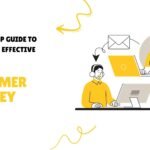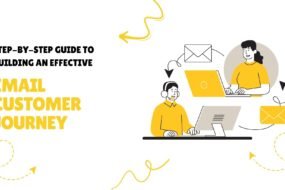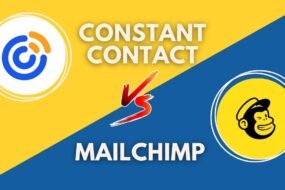
Want to know the benefits of email personalization? Let’s get started. Excellent, data-driven tactics that bring substantial ROI are the key to strategic email marketing. However, if you’ve ever opened an email that focused solely on the brand and not your pain points, you know they lack a personal connection with users. Email personalization allows you to create customized messages that address individual needs and preferences, fostering a stronger bond with your audience.
Thus, you should build up strategies that directly hit your readers like a storm and make them believe that your product or service is made only to solve their issue.
How Does Email Personalization Help?
Email Personalization is a powerful tool for engaging subscribers, driving conversions, and building stronger relationships with your audience. By collecting relevant data, segmenting your audience, and delivering tailored content based on subscriber preferences and behavior, you can create more impactful email campaigns that resonate with recipients.
Personalizing subject lines, email copy, and content recommendations can significantly increase open rates, click-through rates, and overall engagement. Triggered emails based on specific subscriber actions or behaviors allow you to deliver timely and relevant messages that drive conversions.
It’s essential to respect subscriber privacy and preferences, obtain consent for data collection and use, and provide clear options for subscribers to manage their preferences and unsubscribe if desired.
Regularly monitoring and analyzing the performance of your personalized email campaigns allows you to identify areas for improvement and make data-driven decisions to optimize your strategies continuously.
Various big brands are personalizing their emails and serving their customers better. Apart from getting new customers, they have also successfully retained them.
- EasyJet made use of a personalized story.
- Adidas segmented the list as per gender.
- Sephora influenced VIP status.
- Flight Centre segmented as per the customer data.
- Nissan sent out maintenance milestones.
One can predict from these above brands as they aren’t scared of personalizing the emails. With their personalization strategies, they’re able to provide their customer with accurate information. Seeking inspiration from these brands, you can also experience improved open rates and conversions.
Email Personalization Best Practices
Email personalization is a powerful strategy to engage subscribers and drive conversions. Here are some best practices for effective email personalization:
- Collect Relevant Data: Gather data on subscriber preferences, behaviour, demographics, and purchase history to personalize your email content effectively.
- Use Dynamic Content: Tailor email content dynamically based on subscriber data, such as location, past purchases, browsing history, or engagement with previous emails.
- Segment Your Audience: Divide your email list into smaller segments based on demographics, interests, purchase history, or engagement level to deliver more targeted and relevant content to each group.
- Personalize Subject Lines and Preheaders: Incorporate the recipient’s first name or other relevant information into subject lines and preheaders to grab attention and increase open rates.
- Customize Email Copy: Personalize the email copy based on subscriber data and segmentation, addressing recipients by their first name and tailoring the message to their interests and preferences.
- Recommend Relevant Products or Content: Use personalized product recommendations or content suggestions based on the recipient’s past purchases, browsing history, or preferences to increase engagement and drive conversions.
- Send Triggered Emails: Set up triggered email campaigns based on specific subscriber actions or behaviours, such as abandoned carts, website visits, or email clicks, to deliver timely and relevant messages.
- Optimize Send Times: Analyze data to determine the optimal times and days to send personalized emails based on recipient behaviour and engagement patterns.
- Test and Iterate: A/B test different elements of your personalized emails, such as subject lines, content, calls-to-action, and send times, to identify what resonates best with your audience and continuously optimize your campaigns.
- Respect Subscriber Privacy and Preferences: Obtain consent for data collection and use, and provide clear options for subscribers to manage their preferences and unsubscribe if desired. Respect subscriber privacy and only use data for relevant and appropriate personalization efforts.
- Monitor and Analyze Performance: Regularly track key metrics such as open rates, click-through rates, conversion rates, and unsubscribe rates to evaluate the effectiveness of your personalized email campaigns and make data-driven decisions for improvement.
By following these email personalization best practices, you can create more relevant, engaging, and effective email campaigns that resonate with your audience and drive results.
Email Personalization Advance Techniques
- Personalized Subject Lines: Subject lines in email marketing have tremendous importance. And the subject lines in emails differ from one industry to another. With the help of Drip, you can do a/b testing for your subject lines and see which style worked best for your audience. If the subject line is compelling enough, the open and conversion rates are in your favor.
- Track Cart Abandoners: Shoot an email to those customers who have added the products to the shopping cart. Send an invitation to return to their cart by including the product photos and merely showing the total price. To motivate them to make a Hurry Up purchase, offer a discount limited to time.
- Recommend Products As Per Their Taste: Use your customers’ browsing history and offer them products similar to their choice. With this tactic, you’ll be on the right track, taking your customer to a product purchase. You can also cross-sell valuable items or offer a modernized version.
- Celebrate your customers’ success: If offering any service, say, a web design course or a language course, by availing your services, celebrate their achievement by sending them an Email depicting you care for them.
- The urgency with Times & Dates: Many available tools make it easy to add times and dates into your emails. Showing your customer speed can increase your engagement, as no one loves missing out on a fantastic offer. To manage your reminders to send urgent emails, you can use Zoho. As it makes your job easy to remember, you must send an email at a particular time.
What Not To Do While Email Personalization?
While email personalization can greatly enhance engagement and improve the effectiveness of your email marketing campaigns, there are certain pitfalls to avoid. Here’s what not to do while implementing email personalization:
- Overuse of First Name Tags: While addressing recipients by their first name can add a personal touch, overusing it in every sentence can be forced and insincere.
- Incomplete or Inaccurate Data: Sending personalized emails based on incomplete or inaccurate data can lead to embarrassing mistakes or irrelevant content, damaging your brand reputation.
- Being Too Intrusive: Avoid using overly personal information or references in your emails, as it can make recipients uncomfortable and invade their privacy.
- Generic Personalization: Generic personalization, such as simply inserting the recipient’s name into a mass email template without any meaningful customization, can be easily recognized and perceived as impersonal.
- Ignoring User Preferences: Neglecting to respect subscribers’ preferences and sending irrelevant or unwanted content can increase unsubscribe rates and decrease engagement.
- Overly Aggressive Retargeting: Bombarding subscribers with emails based on browsing or purchase history can be perceived as intrusive and may lead to annoyance or unsubscribes.
- Ignoring Timing and Frequency: Sending personalized emails at inappropriate times or too frequently can lead to email fatigue and disengagement from your audience.
- Ignoring Segmentation: Failing to segment your audience effectively can send irrelevant content to subscribers, diminishing the effectiveness of your email personalization efforts.
- Lack of Testing and Optimization: Neglecting to test and optimize your personalized email campaigns can result in missed opportunities for improvement and suboptimal performance.
- Failure to Provide Value: Ultimately, the key to successful email personalization is providing value to your subscribers. Avoid sending emails solely focused on sales pitches or promotional offers without offering meaningful content or solutions to recipients’ needs.
By avoiding these common pitfalls and focusing on delivering relevant, valuable, and respectful personalized experiences, you can maximize the effectiveness of your email marketing campaigns and build stronger relationships with your audience.
Email Personalization Examples
Email personalization is a powerful strategy to enhance engagement and build stronger connections with your audience. Here are some examples of email personalization:
First Name Personalization
Addressing recipients by their first name in the email body or subject line. For instance, “Hi Michael, Check Out Our Latest Collection!”
Behavioural Triggers
Sending emails triggered by specific actions or behaviours. For example, a “We Miss You email” to re-engage inactive subscribers or a “Thank You email” after a purchase.
Location-Based Offers
Offering promotions or event invitations based on the recipient’s geographic location. For instance, “Exclusive Event in Your City: RSVP Now!”
Anniversary or Birthday Emails
Sending personalized emails to celebrate milestones such as the subscriber’s birthday or anniversary with your brand.
Re-engagement Campaigns
Sending targeted emails to subscribers who haven’t engaged with your emails or visited your website in a while, encouraging them to re-engage with your brand.
Abandoned Cart Emails
Remind customers about items left in their shopping cart and offer incentives to complete the purchase.
Post-Purchase Follow-Up
Sending follow-up emails after purchase to thank customers for their order, provide order updates, and suggest related products or services.
By incorporating email personalization techniques like these, you can create more relevant and engaging email experiences for your subscribers, ultimately leading to higher open rates, click-through rates, and conversions.
Conclusion
In conclusion, email personalization enables you to deliver more relevant and meaningful experiences to your subscribers, ultimately leading to higher engagement, increased conversions, and greater long-term loyalty. By incorporating email personalization best practices into your marketing efforts, you can unlock the full potential of your email campaigns and achieve your business goals effectively.








No Comments